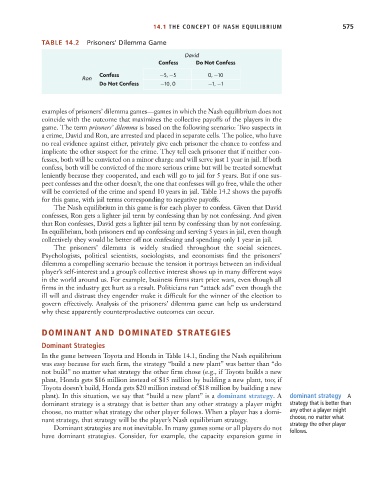Page 601 - Microeconomics, Fourth Edition
P. 601
c14gametheoryandstrategicbehavior.qxd 8/6/10 8:22 AM Page 575
14.1 THE CONCEPT OF NASH EQUILIBRIUM 575
TABLE 14.2 Prisoners’ Dilemma Game
David
Confess Do Not Confess
Ron Confess 5 , 5 0, 10
Do Not Confess 10 , 0 1 , 1
examples of prisoners’ dilemma games—games in which the Nash equilibrium does not
coincide with the outcome that maximizes the collective payoffs of the players in the
game. The term prisoners’ dilemma is based on the following scenario: Two suspects in
a crime, David and Ron, are arrested and placed in separate cells. The police, who have
no real evidence against either, privately give each prisoner the chance to confess and
implicate the other suspect for the crime. They tell each prisoner that if neither con-
fesses, both will be convicted on a minor charge and will serve just 1 year in jail. If both
confess, both will be convicted of the more serious crime but will be treated somewhat
leniently because they cooperated, and each will go to jail for 5 years. But if one sus-
pect confesses and the other doesn’t, the one that confesses will go free, while the other
will be convicted of the crime and spend 10 years in jail. Table 14.2 shows the payoffs
for this game, with jail terms corresponding to negative payoffs.
The Nash equilibrium in this game is for each player to confess. Given that David
confesses, Ron gets a lighter jail term by confessing than by not confessing. And given
that Ron confesses, David gets a lighter jail term by confessing than by not confessing.
In equilibrium, both prisoners end up confessing and serving 5 years in jail, even though
collectively they would be better off not confessing and spending only 1 year in jail.
The prisoners’ dilemma is widely studied throughout the social sciences.
Psychologists, political scientists, sociologists, and economists find the prisoners’
dilemma a compelling scenario because the tension it portrays between an individual
player’s self-interest and a group’s collective interest shows up in many different ways
in the world around us. For example, business firms start price wars, even though all
firms in the industry get hurt as a result. Politicians run “attack ads” even though the
ill will and distrust they engender make it difficult for the winner of the election to
govern effectively. Analysis of the prisoners’ dilemma game can help us understand
why these apparently counterproductive outcomes can occur.
DOMINANT AND DOMINATED STRATEGIES
Dominant Strategies
In the game between Toyota and Honda in Table 14.1, finding the Nash equilibrium
was easy because for each firm, the strategy “build a new plant” was better than “do
not build” no matter what strategy the other firm chose (e.g., if Toyota builds a new
plant, Honda gets $16 million instead of $15 million by building a new plant, too; if
Toyota doesn’t build, Honda gets $20 million instead of $18 million by building a new
plant). In this situation, we say that “build a new plant” is a dominant strategy. A dominant strategy A
dominant strategy is a strategy that is better than any other strategy a player might strategy that is better than
choose, no matter what strategy the other player follows. When a player has a domi- any other a player might
nant strategy, that strategy will be the player’s Nash equilibrium strategy. choose, no matter what
Dominant strategies are not inevitable. In many games some or all players do not strategy the other player
follows.
have dominant strategies. Consider, for example, the capacity expansion game in

